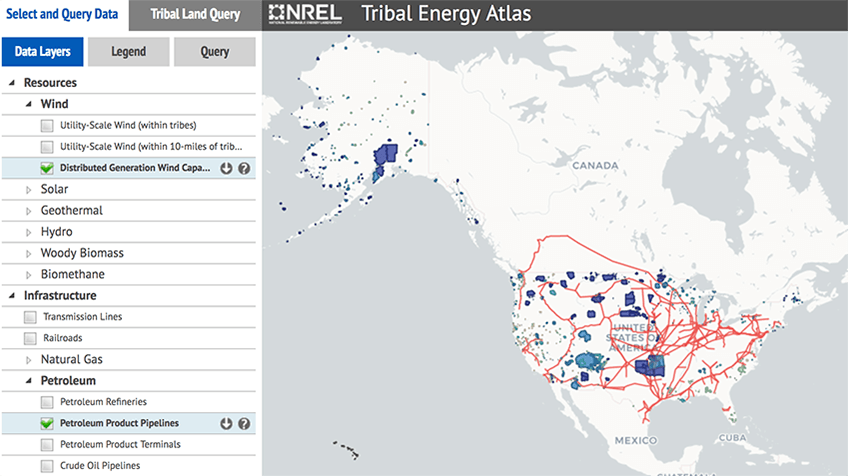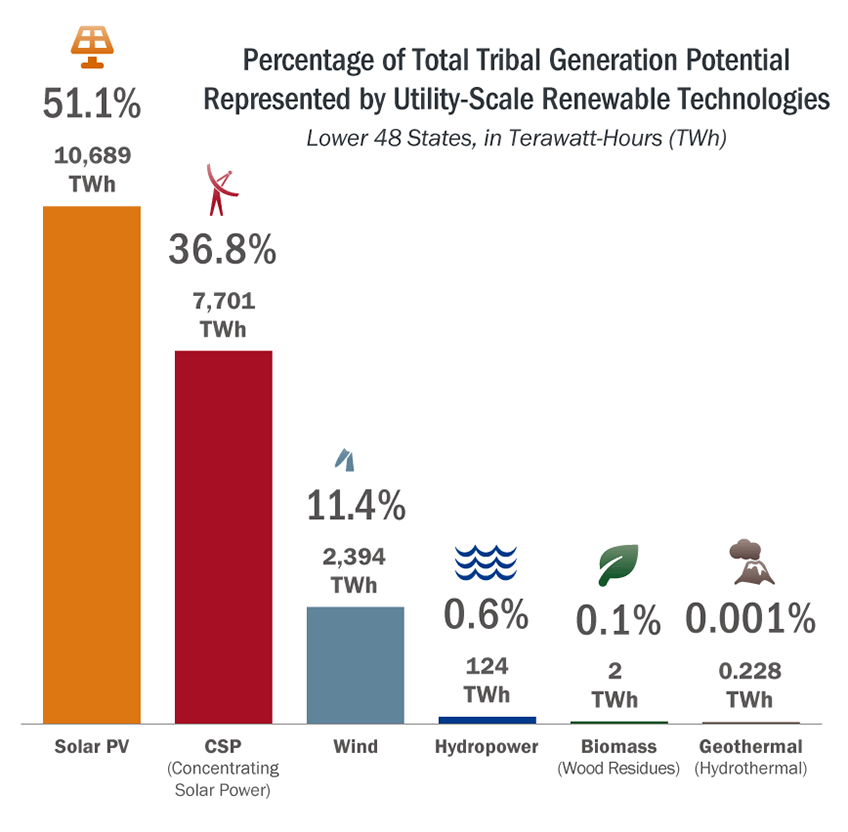NREL-Developed Tribal Energy Atlas Puts Resource Data in Tribes' Hands
A growing number of American Indian tribes and Alaska Native villages are pursuing ambitious energy development goals to tap into the significant energy resource potential that exists on their lands. NREL has just made the first step in this process easier by releasing a new tool that gives tribes unprecedented access to data on their resources.

Screenshot of the user-friendly Tribal Energy Atlas tool.
The Tribal Energy Atlas is a first-of-its-kind interactive geospatial application that allows tribes and others to conduct their own analyses of installed energy projects and resource potential on tribal lands. Developed by NREL researchers with funding from the U.S. Department of Energy (DOE) Office of Indian Energy, it’s the most robust tool ever designed to assist tribal energy project planners, technicians, and investors with analyzing energy options in Indian Country.
This new tool builds on NREL’s past efforts to provide credible research and analytics to identify impactful opportunities for energy development on tribal lands.
A team of NREL analysts used the latest energy resource data to populate the Tribal Energy Atlas, along with other relevant information on infrastructure (e.g., conventional and renewable energy facilities, transmission lines, railroads), environment (e.g., water availability, protected areas), energy efficiency, electricity and natural gas prices, and more. The data is not limited to renewable energy, and also includes natural gas, petroleum, and other conventional energy sources.
In addition to giving tribes unprecedented access to data, the tool also incorporates functionality that enables users to query the data by tribal land and conduct simple analyses of demographics, installed capacity, utility-scale renewable energy technical potential, and more. The Tribal Energy Atlas also includes built-in tutorials to assist users, as well as the ability to provide direct feedback on usability within the application.
The Data Behind the Tool: Updated Techno-Economic Analysis
Behind the Tribal Energy Atlas is a wealth of updated analysis on renewable energy potential on tribal lands. Specifically, the new report Techno-Economic Renewable Energy Potential on Tribal Lands, recently released by NREL and funded by the DOE Office of Indian Energy, documents the most current technical and economic tribal energy potential estimates included in the Tribal Energy Atlas. This study updates, refines, and expands upon the information presented in the 2013 report Geospatial Analysis of Renewable Energy Technical Potential on Tribal Lands, also authored by NREL with funding from the DOE Office of Indian Energy.
The analysis behind the tool draws upon a variety of reliable sources, including resource assessment and technology models developed by NREL, the U.S. Census Bureau, the U.S. Geological Survey, the U.S. Department of Agriculture, and the Energy Information Administration. Inputs NREL used to perform the analysis include resource estimates, renewable energy cost and generation attributes, regional market electricity prices, and energy-support policies, among others. The resources analyzed include wind, solar photovoltaics (PV), concentrating solar power (CSP), woody biomass, biogas, geothermal, and hydropower.
Although the study focuses primarily on utility-scale renewable energy potential on tribal lands in the lower 48 states, it also highlights information on distributed-scale renewable energy technical and economic potential, which includes Alaska Native villages.
Key results from the techno-economic potential analysis include:
- While tribal lands make up approximately 5.8% of the land area in the conterminous United States, the estimated utility-scale renewable energy technical potential on these lands is 6.5% of the total national renewable energy technical potential.
- Solar PV is the top-ranking tribal utility-scale renewable energy resource, followed by CSP and wind, with relatively smaller contributions from other technologies.
- While distributed wind and PV potential exists to some degree for every tribal area, in low-resource areas they may not be cost-competitive with existing grid electricity prices.

Solar resources account for nearly 90% of renewable energy generation potential on tribal lands in the conterminous 48 states.
Learn More About Our Work With Tribes
NREL’s research in support of the DOE Office of Indian Energy is part of the lab’s efforts to provide state, local, and tribal government leaders with analysis, outreach, training, and technical assistance to transfer knowledge and innovation to solve the nation's energy challenges. The goal of this work is to support informed energy decision making with credible, technology-neutral, accessible, and timely resources.
Learn more about NREL’s work with tribal governments.
For more information on the techno-economic potential of renewable energy on tribal lands, download the report, and to explore the data, visit the Tribal Energy Atlas.
Last Updated May 28, 2025
